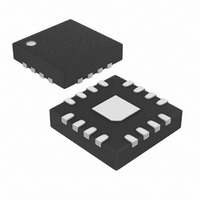MAX4211DETE+ Maxim Integrated Products, MAX4211DETE+ Datasheet - Page 22

MAX4211DETE+
Manufacturer Part Number
MAX4211DETE+
Description
IC CURRENT MONITOR 1.5% 16TQFN
Manufacturer
Maxim Integrated Products
Datasheet
1.MAX4211BEUE.pdf
(32 pages)
Specifications of MAX4211DETE+
Function
Current Monitor
Sensing Method
High-Side
Accuracy
±1.5%
Voltage - Input
4 ~ 28 V
Operating Temperature
-40°C ~ 85°C
Mounting Type
Surface Mount
Package / Case
16-TQFN Exposed Pad
Product
Power Monitors
Supply Voltage (max)
5.5 V
Supply Voltage (min)
2.7 V
Operating Temperature Range
- 40 C to + 85 C
Mounting Style
SMD/SMT
Supply Current (max)
1100 uA
Lead Free Status / RoHS Status
Lead free / RoHS Compliant
Current - Output
-
Lead Free Status / Rohs Status
Lead free / RoHS Compliant
Ideally, the maximum load current develops the full-
scale sense voltage across the current-sense resistor.
Choose the gain version needed to yield the maximum
current-sense amplifier output voltage without saturat-
ing it. The typical high-side saturation voltage is about
V
is given by:
where V
or at IOUT. V
current-sense amplifier gain of the device specified in
Table 1. Calculate the maximum value for R
the differential voltage across RS+ and RS- does not
exceed the full-scale sense voltage:
Choose the highest value resistance possible to maxi-
mize V
applications monitoring high current, ensure that
R
tion. If the resistor’s power dissipation is exceeded, its
value can drift or it can fail altogether, causing a differ-
ential voltage across the terminals in excess of the
absolute maximum ratings. Use resistors specified for
current-sensing applications.
In some applications where undercurrent or underpow-
er (open-circuit fault) and overcurrent or overpower
(short-circuit fault) needs to be monitored, a window
comparator is desirable. Figure 1 shows a simple circuit
suitable for window detection. Let P
mum load power required to cause a low state at
COUT2, and let P
required to cause a high state at COUT1:
where A
in Table 2, and V
(1.2V, typ). The resulting comparator output is high
High-Side Power and
Current Monitors
22
CC
SENSE
P
P
UNDER
OVER
- 0.25V. The current-sense amplifier output voltage
______________________________________________________________________________________
SENSE
IOUT
VPOUT
is able to dissipate its own I
(
WATTS
(
R
WATTS
Recommended Component Values
SENSE
SENSE
is the voltage fed to the analog multiplier
and thus minimize total output error. In
is the power-sense amplifier gain given
Applications Information
V
)
IOUT
)
UNDER
REF
is the sense voltage. A
A
= V
is the internal reference voltage
V
A
VPOUT
I
SENSE FULL SCALE
LOAD FULL SCALE
VPOUT
SENSE
be the maximum load current
V
(
Window Comparator
(
REF
V
REF
x A
R
VIOUT
R
SENSE
SENSE
OVER
2
R power dissipa-
)
)
R
be the mini-
VIOUT
4
R
1
SENSE
R
R
5
2
R
is the
R
5
2
so
when the current is inside the current window and low
when the current is outside the window. Note that
COUT1 and COUT2 are wire-ORed together.
Figure 2 shows a circuit breaker that shuts off current to
the load when an overpower fault is detected (the same
circuit can be used to detect overcurrent conditions by
connecting the R1-R2 resistor-divider to IOUT, instead
of POUT). This circuit is useful for protecting the battery
from short-circuit or overpower conditions. When a
power fault is detected, the P-MOSFET, M1, is turned
off and stays off until the manual reset button is
pressed. Also, cycling the input power causes the LE
pin to go low, which unlatches the comparator output
OUT1 and resets the circuit breaker.
During power-up or when the characteristics of the load
change, there can be an inrush current into the load. The
temporary inrush current results in a higher voltage at
POUT. This can bring the voltage at CIN+ above the ref-
erence voltage at CIN-, and, as a result, COUT1 goes
high triggering the circuit-breaker function. This unwanted
behavior can be disabled by bringing comparator 1’s
INHIBIT input high. An RC network connected to INHIBIT
(R4 and C1) can be incorporated to suspend comparator
1’s operation for a brief period. In this way, short surges in
load power can be made invisible to the circuit-breaker
function, while longer term overpower load demands (or a
load short circuit) still “trip the breaker.”
The logic-high threshold for INHIBIT is typically 1.2V,
and the logic-low threshold is 0.6V. During power-up,
INHIBIT quickly exceeds 1.2V through C1 and inhibits
COUT1 from changing state. The comparator inputs are
“inhibited” until the INHIBIT voltage is discharged to
0.6V. R3 is a current-limiting resistor, typically 10k ,
which protects the INHIBIT input. Since INHIBIT is a
high-impedance input, R3 has no effect on the R4-C1
charge/discharge time. The time during which the com-
parator is suspended is approximated by:
where
improved transient immunity, t
as required, with the understanding that the breaker
function will be suspended for this period.
If any comparator is not used, its input must be biased
to a known state. For example, connect CIN+ to V
and CIN- to GND.
V is the voltage change at the load. For
t
INHIBIT
Overpower Circuit Breaker
R
4
C In
1
INHIBIT
0 6
.
V
V
can be increased
CC











